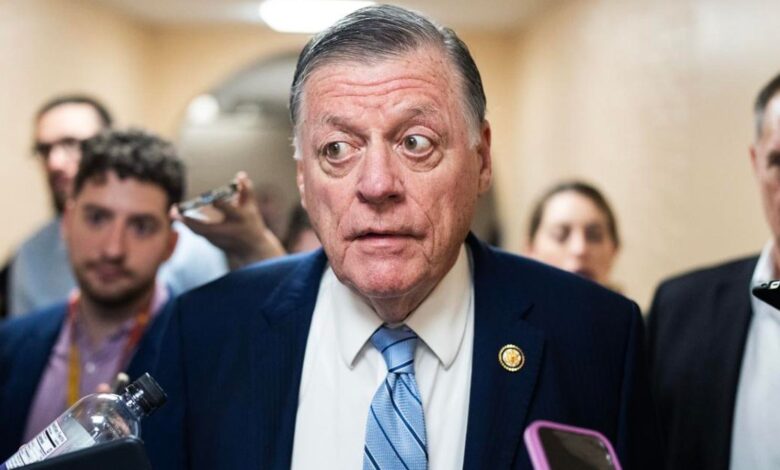Republicans Plan More Cuts To Student Loan And Financial Aid Programs

📝 usncan Note: Republicans Plan More Cuts To Student Loan And Financial Aid Programs
Disclaimer: This content has been prepared based on currently trending topics to increase your awareness.
UNITED STATES – MARCH 11: Rep. Tom Cole, R-Okla., leaves a meeting of the House Republican Conference in the U.S. Capitol on Tuesday, March 11, 2025. (Tom Williams/CQ-Roll Call, Inc via Getty Images)
CQ-Roll Call, Inc via Getty Images
Republican lawmakers in Congress are planning on enacting further cuts to key Department of Education programs. The proposed spending reductions, which are part of a broader government funding bill that House HOP leaders released this week, would impact millions of college students as well as existing borrowers pursing affordable repayment plans and student loan forgiveness, if they are enacted.
The proposal comes only three months after President Donald Trump signed the “One Big, Beautiful Bill Act” into law, which passed the House and Senate on a party-line vote. That legislation will make significant changes to federal student loan repayment and loan forgiveness programs over the next three years. Critics have argued that the reforms will increase the cost of repayment for existing student loan borrowers while making it harder and more expensive for Americans to get a college or graduate degree.
The latest budget proposal by Republican leaders builds on the changes imposed by the “One, Big, Beautiful Bill Act.” GOP leadership touted the proposed cuts to government spending that would go into effect, if the bill ultimately passes Congress.
“This bill supports President Trump’s efforts to safeguard taxpayer dollars, eliminate out of-touch progressive policies, and end the weaponization of government by eliminating or reducing more than 100 programs,” said House Appropriations Committee Chairman Tom Cole in a statement accompanying a summary of the bill on Monday.
Here’s what the proposed funding cuts could mean for student loan borrowers.
Department of Education Cuts Could Worsen Student Loan Program Backlogs
At a high level, the House Republican proposal calls for $12 billion in cuts to Department of Education funding. This would represent a 15% reduction in current funding levels, from $79 billion to $67 billion.
The cuts to department funding could not come at a worse time for student loan borrowers. The department is contending with massive backlogs across a number of different repayment and student loan forgiveness programs. There is a 1.3 million application backlog for income-driven repayment plan applications, and a 72,000 application backlog for the PSLF Buyback program, which offers public service borrowers an opportunity to make a lump-sum payment toward student loan forgiveness. While the IDR application backlog has been somewhat reduced from 1.5 million during the last few months, the PSLF Buyback backlog has increased by more than 20,000 applications, even as the department has been steadily processing them. In the meantime, Trump administration officials separately revealed earlier this summer that there is a backlog of more than 41,000 dispute cases submitted by borrowers to the Office of Federal Student Aid’s Feedback unit and the Ombudsman group (of these, more than 27,000 open cases are with the Ombudsman).
Critics have argued that the mass Department of Education layoffs and staff buyouts imposed by the Trump administration earlier this year have only worsened these backlogs. And even without further funding cuts or staff reductions, these backlogs may only continue to grow as millions of student loan borrowers are forced to change repayment plans during the next several years under the One, Big, Beautiful Bill Act. Further cuts to department programs could have catastrophic impacts.
Cuts To Financial Aid Programs Could Lead To More Private Student Loan Borrowing
The Republican appropriations bill also calls for cuts to several federal financial aid programs. While Pell Grant funding would be preserved, the proposed legislation would eliminate the Federal Supplemental Educational Opportunity Grant, which offered nearly $1 billion in financial aid last year to high need students. The bill would also dramatically slash the Federal Work-Study program, which allows students to work during their degree program to help them offset the cost of tuition; funding would be reduced by 36% under the proposal.
The proposed reductions follow massive cuts to federal student loan loan programs that will soon go into effect under the One, Big, Beautiful Bill. Under that legislation, Parent PLUS loans will be capped, the Graduate PLUS loan program will be fully eliminated, and federal Stafford loans will also face limits.
“Effective July 1, 2026, the law eliminates the Graduate PLUS loan program,” said The Institute for College Access and Success in a blog post earlier this summer. “Graduate student borrowing will be capped at $20,500 per year, with a lifetime borrowing limit of $100,000. Professional student borrowing will be capped at $50,000 per year, with a $200,000 lifetime borrowing limit. The current Graduate PLUS program allows graduate and professional students to borrow up to the full cost of attendance each year.”
New student loan borrowers will also be severely limited in their repayment plan options. Borrowers who consolidate or take out new student loans on or after July 1, 2026 will only be able to access one income-driven repayment plan, which some critics have characterized as a “debt trap.”
Taken together, higher education and student loan borrower advocates have expressed concerns that these reforms will collectively force Americans to rely more on private student loans to cover the costs of a degree. Private student loans are often risker and costlier than federal student loans as they tend to have higher interest rates, fewer repayment plan options, and no pathway to student loan forgiveness. Other prospective students may decide to forego higher education entirely, which could limit future employment opportunities.
“The Senate bill makes $300 billion in cuts to higher education and guts critical protections” by “gutting the Graduate PLUS loan program and limiting access to Parent PLUS loans, pushing families into predatory private debt or out of higher education entirely,” said the Student Borrower Protection Center in July following passage of the One, Big, Beautiful Bill Act.
What Student Loan Borrowers Should Know
For now, the new appropriations bill that would cut even more funding to student loan programs and financial aid is just a proposal. It must clear several procedural hurdles before it can become law. The bill also may require Democratic support in the Senate to overcome a filibuster, which may limit Republican lawmakers’ ability to impose draconian cuts.
But with complete GOP control of the House, the Senate, and the White House, Democrats don’t necessarily have a lot of leverage. And even if they can prevent further funding cuts, the backlogs associated with disputes, income-driven repayment, and student loan forgiveness program are showing no signs of significant improvement. With more big changes on the horizon for student loan programs under the One, Big, Beautiful Bill, there likely is more turbulence ahead for borrowers.




